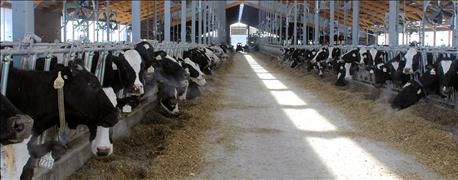
Despite relatively strong milk production, increasing stocks of dairy products and weak exports, dairy product prices surprisingly strengthened in June.
"On the Chicago Mercantile Exchange, butter which average $2.0554 per pound in May is now $2.36," says Bob Cropp, University of Wisconsin-Madison dairy economist. Barrel cheese and 40-pound block cheese which averaged $1.3529 per pound and $1.3174 per pound respectively in May has risen to $1.545 and $1.5125 respectively.
"So we can expect the Class III price which was a low of $12.76 in May to be near $$13.25 in June, and the Class IV price which was $13.09 in May to be near $13.79," Cropp says.

GOOD DAIRY NEWS: Butter and cheese sales are expected to remain strong.
Sales of butter and cheese have been good particularly in food service. But, exports have been weak compared to a year ago. Nonfat dry milk powder is lower by 19% while cheese exports have dropped 33% and butter is down 44%, according to Cropp.
"So the question is will these dairy product prices hold or even increase more? If so, milk prices will be considerably higher for the remainder of 2016 than what has been forecasted," he says.
USDA’s June forecast still has the Class III price averaging for the year $13.40 to $13.80 and the Class IV price averaging $13.15 to $13.65. Class III averaged $15.80 last year and the Class IV price averaged $14.35. Both Class III and Class IV futures have responded to higher dairy product prices.
"Currently, Class III futures jumped to $15.05 for July and then in the $16’s for August through November with December in the high $15s. Class IV futures jump to $15.59 for July and then the $16’s for the remainder of the year," Cropp notes. "The price of corn, soybean meal and alfalfa hay have all increased. So these higher prices are much needed to improve margins for dairy producers."
Whether these dairy product prices hold or improve even more and increasing dairy producer prices will depend a lot upon the level of milk production, Cropp says. Butter and cheese sales are expected to remain strong. USDA’s report on milk production shows a continuation of relatively strong milk production with May being up 1.2% from May a year ago. But, the report shows milk cows have stopped increasing and have been at 9.327 million head for the past three months and were just 3,000 head higher than a year ago. The increase in milk production is being driven by more milk per cow. Last year milk per cow increased well below trend at just 0.6%.
Milk production remains very strong in the Northeast with production up 4.9% in New York and 6.9% in Michigan.Milk production also remains strong in the Midwest with production up 2.3% in Iowa, 2.2% in Minnesota, 9.5% in South Dakota and 4.2% in Wisconsin. The picture is somewhat mixed in the West with California continuing to see milk production 2.8% lower and New Mexico down 3.8%, while milk production in Texas increased 4.8%.
The improvement in dairy product prices and milk prices is driven not only by expected strong butter and cheese sales, but also by the weather.
"Weather forecasts show that with La Nino conditions there is a high probability of hot and humid temperatures and dry conditions for the Central, Midwest and Northeast regions," Cropp explains. "Grain prices have also moved higher for the same weather conditions. These weather conditions would reduce milk per cow lowering milk production and milk composition, and reducing grain yields as well as the forage supply and increasing feed costs."
There are also signs that world milk production may start to slow. Low milk prices appear to be affecting milk production in New Zealand and Australia and in the European Union. As world milk production slows world dairy product prices will improve, Cropp says. China may start to increase its imports of dairy products. U.S. dairy exports could slowly improve during the second half of the year.
"So the dairy picture looks a little brighter now than it did just a month ago," Cropp concludes.
FREE REPORT: 10 Hay Farming Basics: Producing a Quality Hay Product - Update
About the Author(s)
You May Also Like






